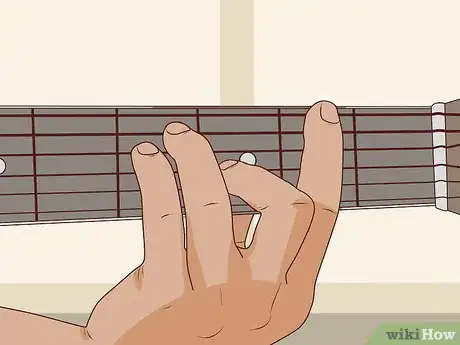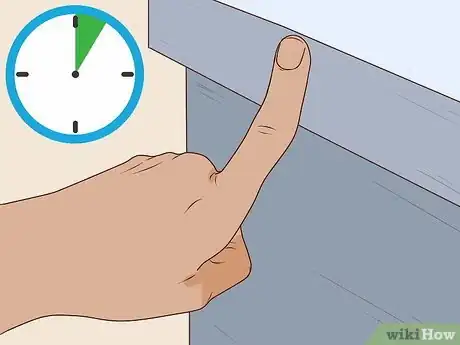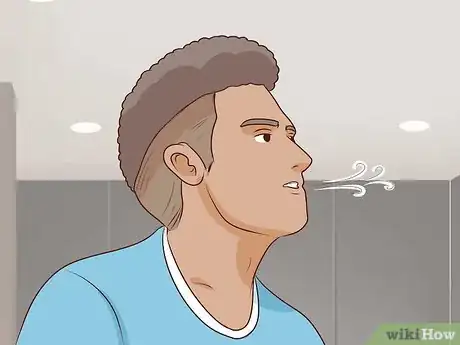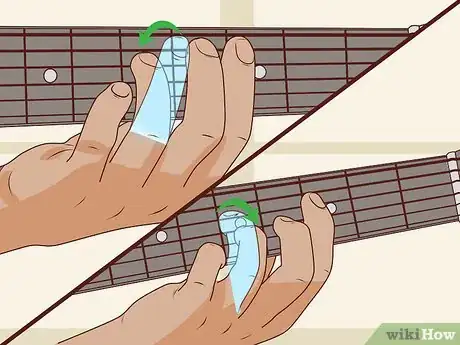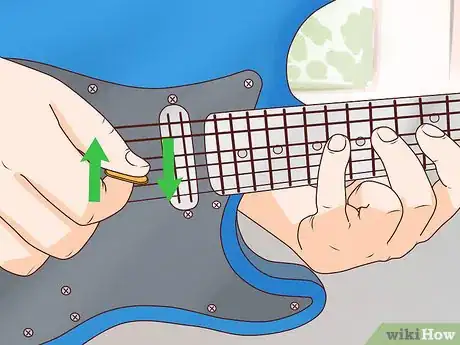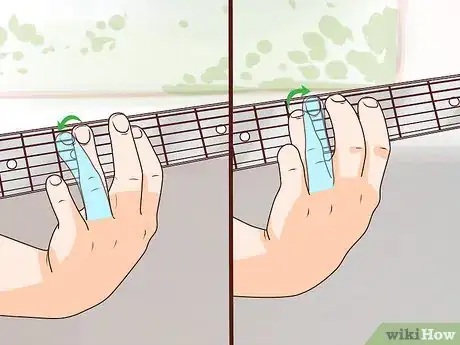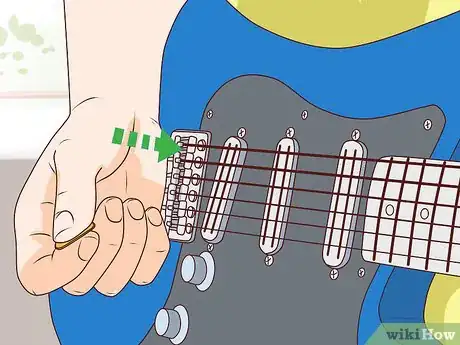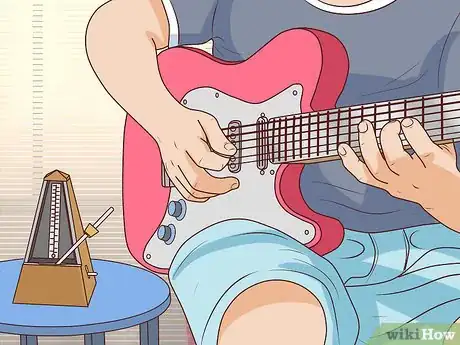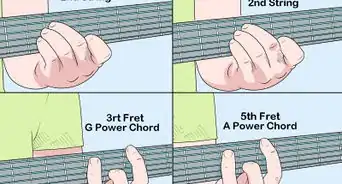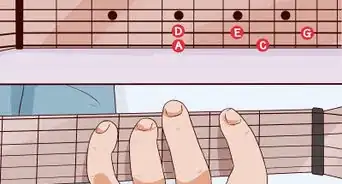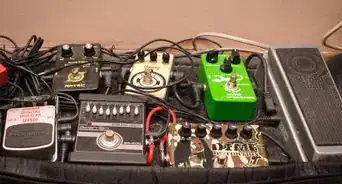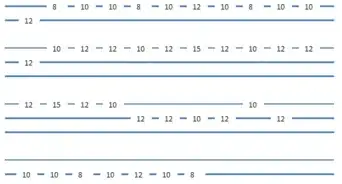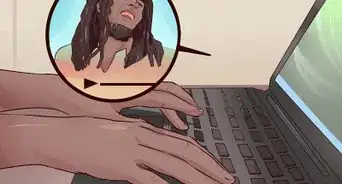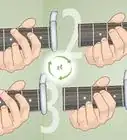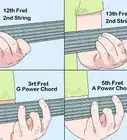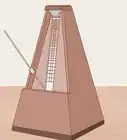This article was co-authored by Nicolas Adams and by wikiHow staff writer, Jennifer Mueller, JD. Nicolas Adams is a 5th generation musician of Serbian Gypsy descent and the lead guitarist of the band Gypsy Tribe. Based in the San Francisco Bay Area, Nicolas specializes in Rumba Flamenco and Gypsy jazz and playing the guitar, Bouzouki, Balalaika, and piano.
This article has been viewed 17,318 times.
If you're starting to play guitar, particularly an electric guitar, you likely want to learn how to play faster – especially if you idolize legendary shredders and soloists in hard rock and heavy metal. The key to playing guitar faster is to isolate each of your hands. Train your fretting hand to get faster, then improve your picking efficiency. When you synchronize your hands together, you'll be well on your way to shredding riffs and licks like your idols.[1]
Steps
Training Your Fretting Hand
-
1Fret notes using your fingertips. If you want to play guitar fast, you need to position your fingers on the strings correctly. Finger position can be difficult, especially for beginning guitarists, and you may have developed some bad habits. Make a "C" shape with your hand, as though you're cupping a ball, and rest the very tips of your fingers on the strings to play.[2]
- Pay attention to the pressure you're placing on the strings. Try lightening the pressure a bit and see if it's easier for you. To play fast, you want to make sure you're only using as much pressure as necessary – it's a lot more effort to press harder.[3]
- You can also make it easier to fret notes by lowering the action on your guitar so there is less distance between the strings and the frets.
-
2Stretch your fingers for 5 to 10 minutes before starting any session. Place the tip of each finger against the edge of a table or desk, straight and in line with the top surface. Push down to bend your finger back until you feel a stretch. Then release and repeat the stretch with all 4 fingers.[4]
- Stretch each finger individually, keeping your other fingers closed against the palm. This encourages finger independence, which is crucial if you want to be able to play fast.
- Point at a wall, keeping your finger straight, and then press down until the pad of your finger is flush with the wall. Again, keep all other fingers closed in your palm. This stretches the first joint of each of your fingers.
- After stretching, gently shake your hands over your head to loosen them up.
EXPERT TIPNicolas Adams is a 5th generation musician of Serbian Gypsy descent and the lead guitarist of the band Gypsy Tribe. Based in the San Francisco Bay Area, Nicolas specializes in Rumba Flamenco and Gypsy jazz and playing the guitar, Bouzouki, Balalaika, and piano.Professional Guitarist
 Nicolas Adams
Nicolas Adams
Professional GuitaristOur Expert Agrees: Your fingertips will need conditioning. Especially if you are playing bass guitar, the bass wears on your hands a lot more than a regular guitar. You may develop calluses at first, but if you moisturize your hands and keep practicing they will fade away.
Advertisement -
3Release the tension in your body. If you tense up the muscles in your back, arms, or even your lower body while playing, it will decrease the flexibility in your joints. Keep your body loose while playing and breathe deeply. Make a mental note to check in on yourself every so often while you're playing and let go of any tension you've built up.[5]
- Tension in your hands and forearms puts excess strain on your wrists, which can lead to carpal tunnel syndrome.
-
4Practice scales with hammer-ons and pull-offs. Scales help you train your picking hand to move between notes cleanly. Because scales are the basic building blocks of many guitar solos, being able to play scales fast will help you shred your next solo or riff.[6]
- Playing scales using hammer-ons and pull-offs allows you to work on the speed and dexterity of your fretting hand by itself, without worrying too much about your picking hand.
Variation: In addition to scales, you can also try trills, an exercise in which you alternate between a hammer-on and a pull-off as quickly as possible. Start by trilling between your first and second finger, then first and third, and so on.
-
5Build strength and dexterity in your fingers. When you first start trying to play guitar faster, you'll likely realize that you don't have enough strength and dexterity in your fingers to keep up – particularly your ring and little fingers. Do daily exercises to strengthen your fingers.[7]
- Many guitar stores sell finger grip strengtheners for guitarists. These devices are highly portable and generally run between $10 and $20. You can also find these online. Look for one, such as the "Xtensor," that provides resistance with stretching as well as squeezing to avoid muscle imbalances in your fingers.
Improving Your Picking Efficiency
-
1Separate your picking hand from your fretting hand. Practice your picking without worrying too much about the notes you're playing. You could even play the same note just to get your hand used to picking cleanly up and down.[8]
- The important thing here is to focus on picking each string cleanly and not allowing notes to bleed into other notes. Each tone should be distinct.
-
2Use a simple down-up down-up picking pattern. This alternate strum pattern is the easiest to keep track of when you're trying to pick fast. Use it to build up muscle memory in your picking hand. For every 4 notes you play, end on the up-stroke so the next 4-note sequence begins on the down-stroke.[9]
- You can also practice sweep picking to produce faster streams of notes.
-
3Take advantage of hammer-ons and pull-offs. Hammer-ons and pull-offs enable you to play faster because you're not actually picking all of those notes. With a series of hammer-ons and pull-offs you can play a significant number of notes at a very fast pace.[10]
- Hammer-ons and pull-offs can help you become a more efficient guitar player overall, which will improve your speed.
Tip: Watch videos of shredders you admire. Watch the way their picking hand moves relative to their fretting hand. Try to identify how many notes they pick versus how many are hammer-ons or pull-offs.
-
4Try a thinner pick at a 45-degree angle against the strings. A heavier pick tends to move more slowly over the strings than a thinner pick. If you hold that pick at a 45-degree angle relative to the guitar strings, you'll encounter less obstruction, which will make it easier to play faster.[11]
- Keep in mind that if you're used to playing with a heavier pick, it may take some time to get used to a thinner pick. Slow your playing down until you can pick the notes accurately, then speed it back up.
- With a thinner, lighter pick, you don't have to hold it as tightly or press as hard to pick the strings. Keep your hand relaxed and your grip relatively loose.
-
5Place your hand on the bridge to provide more stability. Resting your hand against the bridge of your guitar provides a stable pivot point so you can pick with greater coordination and efficiency. Just take care not to press into the bridge with too much weight or you could ruin your tone.[12]
- Practice with this position, as it does restrict the movement of your picking hand somewhat. However, if you stay in the middle pick position you may find it helps you increase your picking speed.
Synchronizing Your Playing Technique
-
1Play a simple 1-2-3-4 exercise using a metronome. With this exercise, you play 4 notes on each string, then 4 notes on the next string, and so on with the remaining strings. These are basic exercises for building dexterity in your fretting hand, but they can also be used to increase your speed.[13]
- You may already be familiar with these exercises. If not, you can find them online or make up your own using the formula of 4 notes on each string.
- You can also try scales or arpeggios instead of the 1-2-3-4 exercise.
-
2Increase your speed by 10 BPM when you can play the notes cleanly. Once you can play the exercise cleanly and accurately at the slowest speed you've set, increase the speed on your metronome by no more than 10 BPM. It won't seem much faster, either to your ears or your hand, but it will help you slowly build up muscle memory to improve your speed.[14]
- For example, if you're playing the exercise at 70 BPM and can easily play it with 100 percent accuracy, you're ready to bump your speed up to 80 BPM. Make sure you can play the exercise at 80 BPM just as easily and automatically as you could at 70 BPM before you take the next bump up to 90 BPM.
Tip: Stay accountable by setting measurable goals for improving your speed and tracking your progress. Note how many attempts it takes to play the exercise flawlessly at each speed before moving up to play at 10 BPM faster.
-
3Let your picking hand lead to start playing even faster. Take a break from the metronome and pick the notes in your exercise as fast as you possibly can with your picking hand. Then bring your fretting hand back into play and try to keep up.[15]
- Your picking hand is typically your dominant hand, which means it's probably easier for you to pick faster than to play notes faster. Push your fretting hand to meet the speed of your picking hand.
- Keep in mind that this exercise is probably going to sound horrible at first. However, if you practice for a few minutes each day, you will gradually get faster.
-
4Use the metronome to speed up riffs in songs. When you start playing a new song or practicing a new riff, your fingers don't have the muscle memory yet to play the song as fast as you can. Slow down the sequence to the speed where you can play it through easily and cleanly. Increase speed from there in 10 BPM increments until you're playing the riff at the speed you want.[16]
- As with the speed drills and exercises, don't move up to the next fastest speed until you can easily play the riff without any mistakes. Aim for accuracy at each speed. If you keep repeating mistakes, there will be mistakes in your muscle memory that will reinforce those mistakes.
Expert Q&A
-
QuestionHow can I improve my guitar speed?
 Nicolas AdamsNicolas Adams is a 5th generation musician of Serbian Gypsy descent and the lead guitarist of the band Gypsy Tribe. Based in the San Francisco Bay Area, Nicolas specializes in Rumba Flamenco and Gypsy jazz and playing the guitar, Bouzouki, Balalaika, and piano.
Nicolas AdamsNicolas Adams is a 5th generation musician of Serbian Gypsy descent and the lead guitarist of the band Gypsy Tribe. Based in the San Francisco Bay Area, Nicolas specializes in Rumba Flamenco and Gypsy jazz and playing the guitar, Bouzouki, Balalaika, and piano.
Professional Guitarist Learn some classical music, no matter if you are a metal player, a rock and roll player or whatever, because it is difficult on a different level. Take everything slow. Never rush into a new learning process. If you want to improve on something, always take it slow because if you can play it slow, you can play it fast. It's all muscle memory. If you can play it slow, you can gradually work your way up to play it fast, so speed is relevant when it comes to learning. And you don't only want to play it, but to understand what you're playing, why it's there, how it moves, understand the whole structure of it.
Learn some classical music, no matter if you are a metal player, a rock and roll player or whatever, because it is difficult on a different level. Take everything slow. Never rush into a new learning process. If you want to improve on something, always take it slow because if you can play it slow, you can play it fast. It's all muscle memory. If you can play it slow, you can gradually work your way up to play it fast, so speed is relevant when it comes to learning. And you don't only want to play it, but to understand what you're playing, why it's there, how it moves, understand the whole structure of it. -
QuestionWhy are small chips breaking from the point of the guitar pick?
 Community AnswerIt means you're picking too hard. Use a thicker pick. The tone is nicer when it is thicker and you can play way faster, plus it feels really smooth.
Community AnswerIt means you're picking too hard. Use a thicker pick. The tone is nicer when it is thicker and you can play way faster, plus it feels really smooth.
References
- ↑ https://www.guitarworld.com/lessons/tips-guitarists-how-build-shredding-speed
- ↑ https://tomhess.net/IncreasingGuitarSpeed.aspx
- ↑ http://www.fretjam.com/play-guitar-fast.html
- ↑ http://www.fretjam.com/finger-stretching-exercises.html
- ↑ http://www.fretjam.com/play-guitar-fast.html
- ↑ https://www.guitarlessons.com/guitar-lessons/lead-guitar/5-tips-for-building-guitar-speed
- ↑ https://www.guitarworld.com/lessons/tips-guitarists-how-build-shredding-speed
- ↑ https://www.guitarworld.com/lessons/tips-guitarists-how-build-shredding-speed
- ↑ https://www.guitarworld.com/lessons/tips-guitarists-how-build-shredding-speed
- ↑ http://www.fretjam.com/play-guitar-fast.html
- ↑ http://www.fretjam.com/play-guitar-fast.html
- ↑ http://www.fretjam.com/play-guitar-fast.html
- ↑ https://www.guitarworld.com/lessons/tips-guitarists-how-build-shredding-speed
- ↑ http://www.fretjam.com/play-guitar-fast.html
- ↑ https://www.guitarworld.com/lessons/tips-guitarists-how-build-shredding-speed
- ↑ http://www.fretjam.com/play-guitar-fast.html
